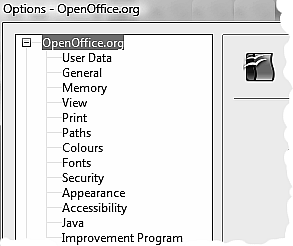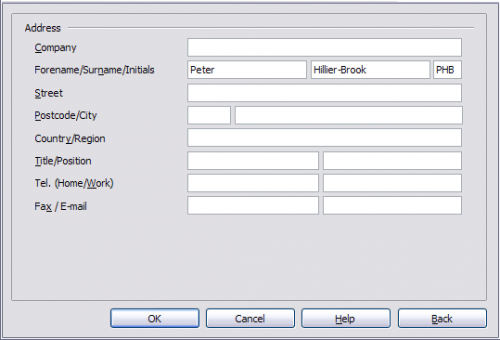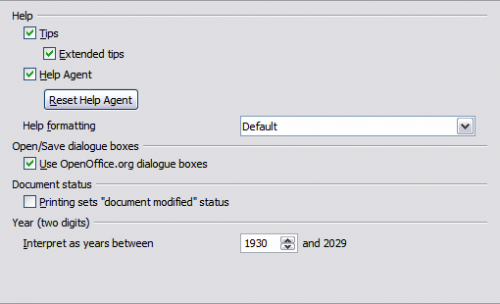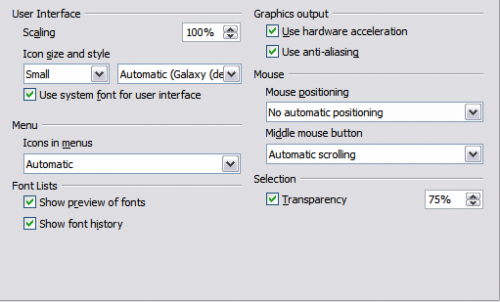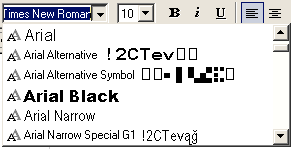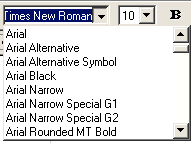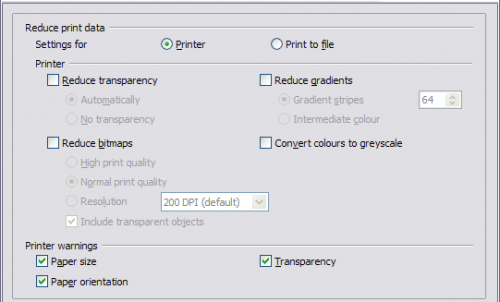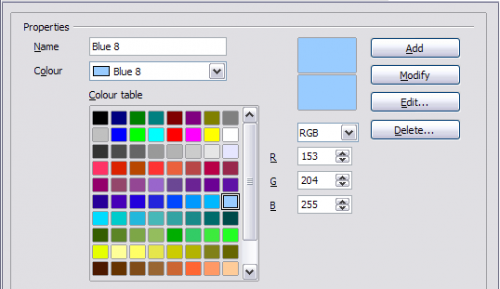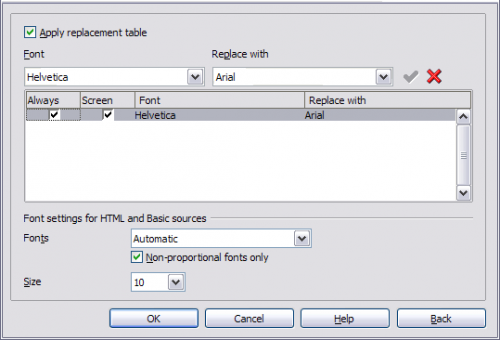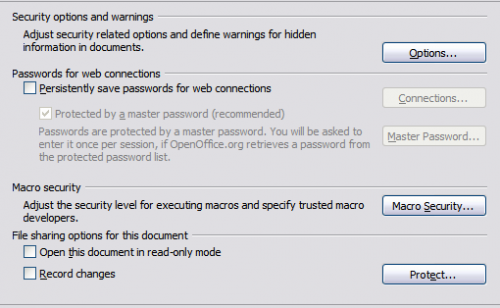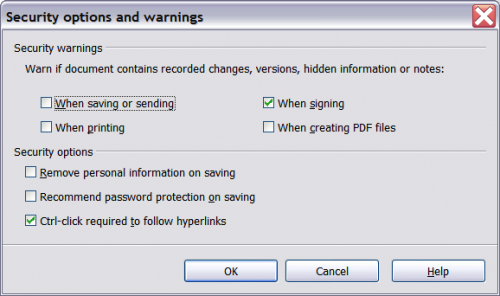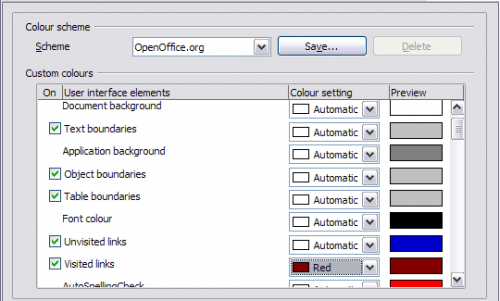Choosing options that affect all of OOo
Contents
OpenOffice.org options
This section covers some of the settings that apply to all the components of OOo. For information on settings not discussed here, see the online help.
- Click Tools > Options. The list in the left-hand box varies depending on which component of OOo is open. The illustrations in this chapter show the list as it appears when no document is open. (For example, when a Writer document is open, additional options for OpenOffice.org Writer and OpenOffice.org Writer/Web appear on the list.)
- Click the + sign to the left of OpenOffice.org in the left-hand section. A list of subsections drops down.
| The Back button has the same effect on all pages of the Options dialog. It resets the options to the values that were in place when you opened OpenOffice.org. |
User Data options
Because OOo's revision features mark your changes and comments with the name or initials stored in User Data, you will want to ensure that your name and initials appear there. To do this:
- In the Options dialog, click OpenOffice.org > User Data.
- Fill in the form on the OpenOffice.org User Data page, or delete any existing incorrect information.
General options for OpenOffice.org
- In the Options dialog, click OpenOffice.org > General.
- On the OpenOffice.org - General page, the options are as described below.
Help - Tips
When Help Tips are active, one or two words will appear when you hover the cursor over an icon or field on the main OOo window. This setting also affects the display of notes: if both Help Tips and Extended Tips are turned off, then you will not see the contents of a note when you hover the cursor on the note.
Help - Extended tips
When Extended tips are active, a brief description of the function of a particular icon or menu command, or a field on a dialog appears when you hover the cursor on that item.
Help Agent
To turn off the Help Agent (similar to Microsoft's Office Assistant), deselect this checkbox. To restore the default Help Agent behavior, click Reset Help Agent.
Help formatting
High contrast is an operating system setting that changes the system color scheme to improve readability. To display Help in high contrast (if your computer's operating system supports this), choose one of the high-contrast style sheets from the list. For Windows XP, the high-contrast style options are as described below.
| High-contrast style | Visual effect |
|---|---|
| Default | Black text on white background |
| High Contrast #1 | Yellow text on black background |
| High Contrast #2 | Green text on black background |
| High Contrast Black | White text on black background |
| High Contrast White | Black text on white background |
Open/Save dialogs
To use the standard Open and Save dialogs for your operating system, deselect the Use OpenOffice.org dialogs checkbox. When this checkbox is selected, the Open and Save dialogs supplied with OpenOffice.org will be used. See Chapter 3 (File Management) (in the Getting Started guide for more about the OOo Open and Save dialogs.
Document status
Choose whether printing a document counts as changing the document. If this option is selected, then the next time you close the document after printing, the print date is recorded in the document properties as a change and you will be prompted to save the document again, even if you did not make any other changes.
Year (two digits)
Specifies how two-digit years are interpreted. For example, if the two-digit year is set to 1930, and you enter a date of 1/1/30 or later into your document, the date is interpreted as 1/1/1930 or later. An “earlier" date is interpreted as being in the following century; that is, 1/1/20 is interpreted as 1/1/2020.
Memory options
- In the Options dialog, click OpenOffice.org > Memory.
- On the OpenOffice.org - Memory dialog:
- More memory can make OpenOffice.org faster and more convenient (for example, more undo steps require more memory); but the trade-off is less memory available for other applications and you could run out of memory altogether.
- To load the Quickstarter (an icon on the desktop or in the system tray) when you start your computer, select the checkbox near the bottom of the dialog. This makes OpenOffice.org start faster; the trade-off is OOo uses some memory even when not being used. This option (called "Enable systray quickstarter") is disabled in some Linux installations.
- File:Options-memory.pngChoosing Memory options for the OpenOffice.org applications.
View options
The choices of View options affect the way the document window looks and behaves.
- In the Options dialog, click OpenOffice.org > View.
- On the OpenOffice.org - View page, set the options to suit your personal preferences. Some options are described below.
User Interface - Scaling
If the text in the help files and on the menus of the OOo user interface is too small or too large, it can be changed by specifying a scaling factor. Sometimes a change here can have unexpected results, depending on the screen fonts available on your system. It does not affect the actual font size of the text.
User Interface - Icon size and style
The first box specifies the display size of toolbar icons (Automatic, Small, or Large); the Automatic icon size option uses the setting for your operating system. The second box specifies the icon set (theme); here the Automatic option uses an icon set compatible with your operating system and choice of desktop: for example, KDE or Gnome on Linux.
User Interface - Use system font for user interface
If you prefer to use the system font (the default font for your computer and operating system), instead of the font provided by OOo, for the user interface, select this checkbox.
User interface - Screen font antialiasing
(Not available in Windows, so not shown in Figure 4.) Select this checkbox to smooth the screen appearance of text. Enter the smallest font size to apply antialiasing.
Menu - icons in menus
Select this option if you want icons as well as words to be visible in menus.
Font Lists - Show preview of fonts
When you select this option, the font list looks like the left picture below, with the font names shown as an example of the font; with the checkbox deselected, the font list shows only the font names, not their formatting (right picture). The fonts you will see listed are those that are installed on your system.
Font Lists - Show font history
When you select this option, the last five fonts you have assigned to the current document are displayed at the top of the font list.
3D view - Use OpenGL
Specifies that all 3D graphics from OpenOffice.org Draw and OpenOffice.org Impress will be displayed in your system using OpenGL-capable hardware. If your system does not have OpenGL-capable hardware, this setting will be ignored.
3D view – Use OpenGL – Optimized output
Select this option for optimized OpenGL output. Disable the optimization in case of graphical errors of 3D output.
3D view – Use dithering
The Use dithering option uses dithering to display more colors with few colors available. Dithering creates the illusion of new colors and shades by varying the pattern of color pixels. Varying the patterns of black and white dots, for instance, produces different shades of gray.
3D view – Object refresh during interaction
Specifies that if you rotate or move a 3-D object, the full display is rotated or moved and not a grid frame.
Mouse positioning
Specifies if and how the mouse pointer will be positioned in newly opened dialog boxes.
Middle mouse button
Defines the function of the middle mouse button.
- Automatic scrolling - dragging while pressing the middle mouse button shifts the view.
- Paste clipboard - pressing the middle mouse button inserts the contents of the “Selection clipboard" at the cursor position.
The “Selection clipboard" is independent of the normal clipboard that you use by Edit > Copy/Cut/Paste or their respective keyboard shortcuts. Clipboard and “Selection clipboard" can contain different contents at the same time.
| Function | Clipboard | Selection clipboard |
|---|---|---|
| Copy content | Edit > Copy Control+C | Select text, table, or object. |
| Paste content | Edit > Paste Control+V pastes at the cursor position. | Clicking the middle mouse button pastes at the mouse pointer position. |
| Pasting into another document | No effect on the clipboard contents. | The last marked selection is the content of the selection clipboard. |
Print options
Set the print options to suit your default printer and your most common printing method. You can change these settings at any time, either through this dialog or during the printing process (by clicking the Options button on the Print dialog).
- In the Options dialog, click OpenOffice.org > Print.
- On the OpenOffice.org - Print dialog, look at the Printer warnings section near the bottom.
- Here you can choose whether to be warned if the paper size or orientation specified in your document does not match the paper size or orientation available for your printer. Having these warnings turned on can be quite helpful, particularly if you work with documents produced by people in other countries where the standard paper size is different from yours.
| If your printouts are coming out incorrectly placed on the page or chopped off at the top, bottom, or sides, or the printer is refusing to print, the most likely cause is page size incompatibility. |
Path options
You can change the location of files associated with, or used by, OpenOffice.org to suit your working situation. In a Windows system, for example, you might want to store documents by default somewhere other than My Documents.
- In the Options dialog, click OpenOffice.org > Paths.
- To make changes, select an item in the list shown in the figure below and click Edit. On the Select Paths dialog (not shown), add or delete folders as required, and then click OK to return to the Options dialog. Note that many items have at least two paths listed: one to a shared folder (which might be on a network) and one to a user-specific folder (normally on the user's personal computer).
| You can use the entries in the OpenOffice.org - Paths dialog to compile a list of files, such as those containing AutoText, that you need to back up or copy to another computer. |
Color options
In the OpenOffice.org - Colors dialog, you can specify colors to use in OOo documents. You can select a color from a color table, edit an existing color, or define new colors. These colors will then be available in color selection palettes in OOo.
Font options
You can define replacements for any fonts that might appear in your documents. If you receive from someone else a document containing fonts that you do not have on your system, OpenOffice.org will substitute fonts for those it does not find. You might prefer to specify a different font from the one the program chooses.
- In the Options dialog, click OpenOffice.org > Fonts.
- On the OpenOffice.org - Fonts dialog:
- Select the Apply Replacement Table checkbox.
- Select or type the name of the font to be replaced in the Font box. (If you do not have this font on your system, it will not appear in the drop-down list in this box, so you need to type it in.)
- In the Replace with box, select a suitable font from the drop-down list of fonts installed on your computer.
- The checkmark to the right of the Replace with box turns green. Click on this checkmark. A row of information now appears in the larger box below the input boxes. Select the checkboxes under Always and Screen.
- In the bottom section of the dialog, you can change the typeface and size of the font used to display source code such as HTML and Basic (in macros).
Security options
Use the OpenOffice.org - Security page to choose security options for saving documents and for opening documents that contain macros.
Security options and warnings
If you record changes, save multiple versions, or include hidden information or notes in your documents, and you do not want some of the recipients to see that information, you can set warnings to remind you to remove this information, or you can have OOo remove some information automatically. Note that (unless removed) much of this information is retained in a file whether the file is in OpenOffice.org’s default OpenDocument format, or has been saved to other formats, including PDF.
Click the Options button to open a separate dialog with specific choices.
Remove personal information on saving. Select this checkbox to always remove user data from the file properties when saving the file. To manually remove personal information from specific documents, clear this checkbox and then use the Delete button under File > Properties > General.
Ctrl-click required to follow hyperlinks. In older versions of OOo, clicking on a hyperlink in a document opened the linked document. Now you can choose whether to keep this behavior (by unchecking this box). Many people find creation and editing of documents easier when accidental clicks on links do not activate the links.
The other options on this dialog should be self-explanatory.
Macro security
Click the Macro Security button to open the Macro Security dialog (not shown here), where you can adjust the security level for executing macros and specify trusted sources.
File sharing options for this document
Select the Open this document in read-only mode checkbox to restrict this document to be opened in read-only mode only. This option protects the document against accidental changes. It is still possible to edit a copy of the document and save that copy with the same name as the original.
Select the Record changes checkbox to enable recording changes. This is the same as Edit - Changes – Record. To allow other users of this document to apply changes, but prevent them from disabling change recording, click the Protect button and enter a password.
Appearance options
Writing, editing, and page layout are often easier to do when you can see as much as possible of what is going on in your document. You may wish to make visible such items as text, table, and section boundaries (in Writer documents), page breaks in Calc, and grid lines in Draw or Writer. In addition, you might prefer different colors (from OOo's defaults) for such items as note indicators or field shadings.
On the OpenOffice.org - Appearance page, you can specify which items are visible and the colors used to display various items.
- In the Options dialog, click OpenOffice.org > Appearance.
- To show or hide items such as text boundaries, select or deselect the checkboxes next to the names of the items.
- To change the default colors for items, click the down-arrow in the Color Setting column by the name of the item and select a color from the pop-up box.
- To save your color changes as a color scheme, type a name in the Scheme box and click Save.
Accessibility options
Accessibility options include whether to allow animated graphics or text, how long help tips remain showing, some options for high contrast display, and a way to change the font for the user interface of the OpenOffice.org program.
Accessibility support relies on Sun Microsystems Java technology for communications with assistive technology tools. See Java options. The "Support assistive technology tools" option is not shown on all OOo installations. See "Assistive Tools in OpenOffice.org" in the Help for other requirements and information.
- In the Options dialog, click OpenOffice.org > Accessibility.
- Select or deselect the options as required.
- File:Options-access.pngChoosing accessibility options.
Java options
If you install or update a Java Runtime Environment (JRE) after you install OpenOffice.org, or if you have more than one JRE installed on your computer, you can use the Java options page to choose the JRE for OOo to use.
If you are a system administrator, programmer, or other person who customizes JRE installations, you can use the Parameters and Class Path pages (reached from the Java page) to specify this information.
- In the Options dialog, click OpenOffice.org > Java.
- If you do not see anything listed in the middle of the page, wait a few minutes while OOo searches for JREs on the hard disk.
- If OOo finds one or more JREs, it will display them there. You can then select the Use a Java runtime environment checkbox and (if necessary) choose one of the JREs listed.
- File:Options-java.pngChoosing a Java runtime environment.
Online Update options
On the Online Update page, you can choose whether and how often to have OOo check the OOo website for program updates. If the Check for updates automatically checkbox is selected, an icon File:OnlineupdateIcon.png appears at the right-hand end of the menu bar when an update is available. Click this icon to open a dialog where you can choose to download the update.
If the Download updates automatically checkbox is selected, the download starts when you click the icon. To change the download destination, click the Change button and select the required folder in the file browser window.
| Content on this page is licensed under the Creative Common Attribution 3.0 license (CC-BY). |
